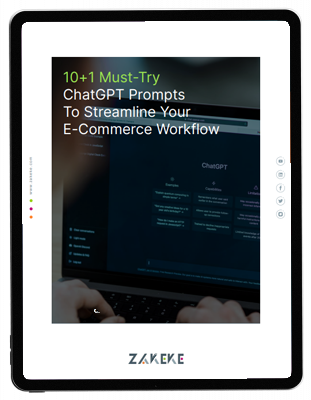E-commerce businesses constantly look for ways to grow. Among smaller ventures, inefficiency is one of the biggest obstacles preventing scaling, so more businesses turn to eCommerce automation.
Small and repetitive tasks consume many resources, complicating the business processes. Managing orders, customer support, and other tasks manually is hardly a winning strategy.
Meanwhile, implementing and utilizing automation solutions creates a self-fulfilling and streamlined workflow.
What Is eCommerce Automation and How Does It Work?
E-commerce automation can be defined as using available software to convert manual tasks into automated tasks.
Developers invest in eCommerce automation software to optimize various aspects of an online store. Different software provides different task automation, and it’s up to the business to decide what processes it wishes to prioritize.
What Types of Tasks Can Be Automated in an eCommerce Setting?
As expected, there are multiple tasks eCommerce businesses can automate. Let’s look at some of the most common and valuable examples.
1. E-commerce Order Fulfillment
E-commerce fulfillment automation is one of the most crucial eCommerce business processes.
Online stores inform customers about new products, back-in-stock goods, or incoming deliveries by triggering emails or text messages.
Specialized tools also simplify warehouse processes to streamline the supply chain. The solution ultimately improves shipping orders and leaves less room for potential errors, thus improving the eCommerce order fulfillment process.
2. Accounting
Accounting is another instance where automation comes in handy. Accounting invoicing and reconciliation take a load off the accounting department’s shoulders.
In addition, the tool integration enables automatic expense tracking if a business has inventory and shipping software compatible with the accounting automation system.
3. Customer Support
A constant stream of incoming customer queries puts a toll on the people working in customer support.
The purpose of customer support automation software is to:
- prioritize tickets based on urgency;
- suggest available resources to check, such as an FAQ section on the website;
- send an automated confirmation message that the query has been received.
4. Security
Considering the volume of cybersecurity threats in eCommerce, it makes sense to implement as many protective measures as possible.
Automating high-risk order identification is one possibility. Whenever someone submits an order from a suspicious location or uses credentials that don’t match (credit card details and delivery address), the order gets flagged automatically.
The team managing and tracking orders then receives and deals with the message. Such a system is more efficient than having to check every order manually.
5. Marketing
The marketing department has multiple opportunities to make things easier for themselves with the help of automation tools.
Some of the best examples include:
- applying discounts to newly uploaded products;
- sending targeted emails and text messages with personalized offers or birthday greetings;
- publishing content on social media and other channels;
- launching a remarketing campaign.
Benefits of eCommerce Automation
The main purpose of eCommerce automation is to improve the overall business process efficiency. Having said that, there are layers to how eCommerce businesses benefit from automation.
1. Boosted Customer Satisfaction
Automation tools enable businesses to function 24/7. Customers don’t have to wait for a response.
A satisfied customer connects with the brand and is more likely to return and produce word-of-mouth marketing.
2. Accurate Inventory Management
Inventory receives regular and immediate updates as soon as the system receives new orders. Customers see live information and know whether an item is available or not.
3. Manual Data Entry Elimination
Thanks to automation, businesses no longer have to waste resources for manual data entry. The time spent on entering numbers and other information can be spent on other, more important tasks.
4. Improved Accuracy
Automation tools reduce errors that occur due to fatigue, distractions, multitasking, and other factors.
Most processes still require human intervention, but automation makes it much easier to handle redundant tasks and improves accuracy.
Who Benefits from eCommerce Automation Tools?
An online store benefits from automation as a whole, but so do individual departments.
- One of the most notable beneficiaries of automation is customer support. Taking care of customer tickets presents fewer challenges when automated messages refer them to the knowledge database;
- Operations managers also have fewer worries after automating order, shipping, and fulfillment processes;
- Web developers don’t have to overburden themselves with theme and template changes and other updates that the website requires;
- Finally, marketers can launch automated campaigns and focus on the creative side of their work, coming up with new methods to approach and convert potential leads.
5 Tips to Start With eCommerce Automation
If you don’t know how to automate eCommerce website, here are a few valuable tips that should point you in the right direction.
1. Identify Key Business Areas That Require Automation
Assess your current business processes and determine areas that would benefit the most from automation.
In the case of small businesses, automating everything might be impossible due to limited resources.
It’s for the best to identify which manual tasks consume the most time and lead to errors. During the initial intake meeting, stakeholders can discuss and prioritize these tasks for efficient automation implementation.
2. Define Your Goals
Implementing eCommerce automation successfully is hard without clear objectives. A business has to determine its aims. The goals range from efficiency by eliminating redundant manual tasks to boosting sales.
A set of clear objectives is a guiding principle, giving a sense of direction for the automation efforts.
3. Choose the Right Tools
Given the magnitude of eCommerce, it should not be surprising that there are so many different automation tools.
Do your research and determine tools that suit your business the most. Look for recommendations and reviews and maximize opportunities to try software via free trials before spending money.
4. Track the Results of Automation Solutions
It takes a while before you see the automation results, but they should show up sooner rather than later.
Keep an eye on automated business processes to determine whether the solution adds real value. After all, you don’t want to continue wasting money on software that fails to meet your expectations.
5. Make Adjustments Where Necessary
Don’t settle for the first option. By tracking the results, make adjustments and look for alternatives if they are there.
Finally, once you can afford to add more automation solutions, do it to improve your eCommerce business operations even further.
Automating Custom Order Fulfillment With Zakeke
E-commerce automation wouldn’t exist without excellent automation solutions. Zakeke is a perfect example of an automation solution that can take your eCommerce business to another level.
Zakeke stands as your ultimate choice for Visual Commerce. Picture this: your customers have the power to customize, view in stunning 3D, AR, and virtually try on your offerings before making a purchase online. Isn’t this the pinnacle of a shopping journey? Now, let’s delve into the world of automation.
Zakeke revolutionizes the way customers craft their unique products online and streamlines the process by instantly delivering production-ready files to your back-office. The journey from seeing the file to kick-starting production is mere seconds. Say goodbye to the tedious chore of creating custom mockups manually and the delays in processing custom orders. Erase the cumbersome manual design tasks, editing mishaps, and the endless chain of design-related emails you’re accustomed to.
Choose Zakeke today. Dive in for FREE today or schedule a quick 10-minute demo to discover more.

Laura Alexander
E-Commerce Content Manager
Laura Alexander is a freelance digital content manager and copywriter. Specializing in tech, ecommerce, and educational content, she had her work appear in publications like Omnikick, Pomodoneapp, Sortlist, and Price2Spy.














